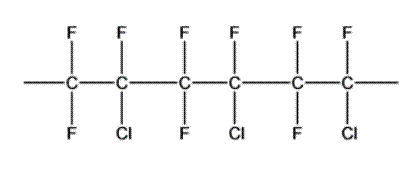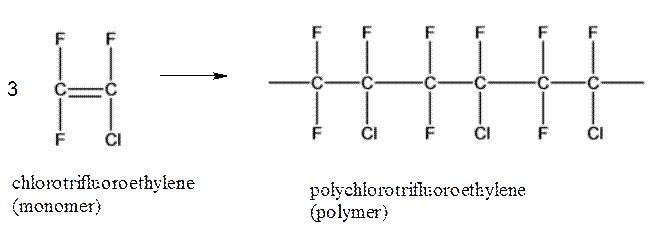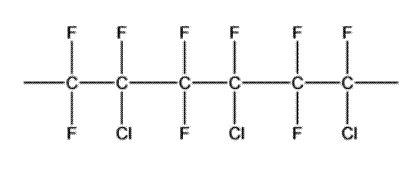
Basic Chemistry (5th Edition)
5th Edition
ISBN: 9780134138046
Author: Karen C. Timberlake
Publisher: PEARSON
expand_more
expand_more
format_list_bulleted
Concept explainers
Question
Chapter 17, Problem 17.61FU
Interpretation Introduction
Interpretation: The expanded structural formula for a portion of polychlorotrifluoroethylene, PCTFE formed from three monomers of chlorotrifluoroethylene should be drawn.
Concept Introduction: The substance which is made up of molecules with a large molecular mass formed by repeating structural units which are connected by covalent bonds are said to be the
Expert Solution & Answer
Answer to Problem 17.61FU

Explanation of Solution
Polychlorotrifluoroethylene, PCTFE, is a polymer in nature, made up from the chlorotrifluoroethylene (monomer) by the process said to be addition
In addition polymerization process, there is no loss of any small molecule and the polymer is formed by simple linking of monomers.

Conclusion

Want to see more full solutions like this?
Subscribe now to access step-by-step solutions to millions of textbook problems written by subject matter experts!
Students have asked these similar questions
What is the pH of a 1.0 L buffer made with 0.300 mol of HF (Ka = 6.8 × 10⁻⁴) and 0.200 mol of NaF to which 0.160 mol of NaOH were added?
Can I please get help with this.
Determine if the following salt is neutral, acidic or basic. If acidic or basic, write the appropriate equilibrium equation for the acid or base that exists when the salt is dissolved in aqueous solution. If neutral, simply write only NR. Be sure to include the proper phases for all species within the reaction. N₂H₅ClO₄
Chapter 17 Solutions
Basic Chemistry (5th Edition)
Ch. 17.1 - LEARNING GOAL Write the IUPAC names and draw the...Ch. 17.1 - Prob. 17.2QAPCh. 17.1 - Prob. 17.3QAPCh. 17.1 - Prob. 17.4QAPCh. 17.1 - Prob. 17.5QAPCh. 17.1 - Prob. 17.6QAPCh. 17.1 - Prob. 17.7QAPCh. 17.1 - Prob. 17.8QAPCh. 17.1 - Prob. 17.9QAPCh. 17.1 - Prob. 17.10QAP
Ch. 17.2 - Prob. 17.11QAPCh. 17.2 - Prob. 17.12QAPCh. 17.2 - Prob. 17.13QAPCh. 17.2 - Prob. 17.14QAPCh. 17.2 - Prob. 17.15QAPCh. 17.2 - Prob. 17.16QAPCh. 17.2 - Prob. 17.17QAPCh. 17.2 - Prob. 17.18QAPCh. 17.2 - Prob. 17.19QAPCh. 17.2 - Prob. 17.20QAPCh. 17.2 - Prob. 17.21QAPCh. 17.2 - Prob. 17.22QAPCh. 17.2 - Prob. 17.23QAPCh. 17.2 - Prob. 17.24QAPCh. 17.3 - Prob. 17.25QAPCh. 17.3 - Prob. 17.26QAPCh. 17.3 - Prob. 17.27QAPCh. 17.3 - Prob. 17.28QAPCh. 17.4 - Prob. 17.29QAPCh. 17.4 - Prob. 17.30QAPCh. 17.4 - Prob. 17.31QAPCh. 17.4 - Prob. 17.32QAPCh. 17.4 - Prob. 17.33QAPCh. 17.4 - Prob. 17.34QAPCh. 17.5 - Prob. 17.35QAPCh. 17.5 - Prob. 17.36QAPCh. 17.5 - Prob. 17.37QAPCh. 17.5 - Prob. 17.38QAPCh. 17.5 - Prob. 17.39QAPCh. 17.5 - Prob. 17.40QAPCh. 17.6 - Prob. 17.41QAPCh. 17.6 - Prob. 17.42QAPCh. 17.6 - Prob. 17.43QAPCh. 17.6 - Prob. 17.44QAPCh. 17.6 - Prob. 17.45QAPCh. 17.6 - Prob. 17.46QAPCh. 17.6 - Prob. 17.47QAPCh. 17.6 - Prob. 17.48QAPCh. 17.6 - Prob. 17.49QAPCh. 17.6 - Prob. 17.50QAPCh. 17.6 - Prob. 17.51QAPCh. 17.6 - Draw the condensed structural formula for each of...Ch. 17.7 - Write the common name for each of the following:Ch. 17.7 - Prob. 17.54QAPCh. 17.7 - Prob. 17.55QAPCh. 17.7 - Prob. 17.56QAPCh. 17.7 - Prob. 17.57QAPCh. 17.7 - Prob. 17.58QAPCh. 17.7 - Prob. 17.59QAPCh. 17.7 - Prob. 17.60QAPCh. 17 - Prob. 17.61FUCh. 17 - 17.62 New polymers have been synthesized to...Ch. 17 - Prob. 17.63FUCh. 17 - Prob. 17.64FUCh. 17 - Prob. 17.65UTCCh. 17 - Prob. 17.66UTCCh. 17 - Prob. 17.67UTCCh. 17 - Prob. 17.68UTCCh. 17 - Prob. 17.69AQAPCh. 17 - Prob. 17.70AQAPCh. 17 - Prob. 17.71AQAPCh. 17 - Prob. 17.72AQAPCh. 17 - Prob. 17.73AQAPCh. 17 - Prob. 17.74AQAPCh. 17 - Prob. 17.75AQAPCh. 17 - Prob. 17.76AQAPCh. 17 - Prob. 17.77AQAPCh. 17 - Prob. 17.78AQAPCh. 17 - Prob. 17.79AQAPCh. 17 - Prob. 17.80AQAPCh. 17 - Prob. 17.81AQAPCh. 17 - Prob. 17.82AQAPCh. 17 - Prob. 17.83AQAPCh. 17 - Prob. 17.84AQAPCh. 17 - Prob. 17.85AQAPCh. 17 - Prob. 17.86AQAPCh. 17 - Prob. 17.87AQAPCh. 17 - Prob. 17.88AQAPCh. 17 - Prob. 17.89AQAPCh. 17 - Prob. 17.90AQAPCh. 17 - Prob. 17.91AQAPCh. 17 - Prob. 17.92AQAPCh. 17 - Draw the condensed structural formula for each of...Ch. 17 - Prob. 17.94AQAPCh. 17 - Prob. 17.95AQAPCh. 17 - Prob. 17.96AQAPCh. 17 - Prob. 17.97CQCh. 17 - Prob. 17.98CQCh. 17 - Prob. 17.99CQCh. 17 - Prob. 17.100CQCh. 17 - Prob. 17.101CQCh. 17 - Prob. 17.102CQ
Knowledge Booster
Learn more about
Need a deep-dive on the concept behind this application? Look no further. Learn more about this topic, chemistry and related others by exploring similar questions and additional content below.Similar questions
arrow_back_ios
SEE MORE QUESTIONS
arrow_forward_ios
Recommended textbooks for you
 ChemistryChemistryISBN:9781305957404Author:Steven S. Zumdahl, Susan A. Zumdahl, Donald J. DeCostePublisher:Cengage Learning
ChemistryChemistryISBN:9781305957404Author:Steven S. Zumdahl, Susan A. Zumdahl, Donald J. DeCostePublisher:Cengage Learning ChemistryChemistryISBN:9781259911156Author:Raymond Chang Dr., Jason Overby ProfessorPublisher:McGraw-Hill Education
ChemistryChemistryISBN:9781259911156Author:Raymond Chang Dr., Jason Overby ProfessorPublisher:McGraw-Hill Education Principles of Instrumental AnalysisChemistryISBN:9781305577213Author:Douglas A. Skoog, F. James Holler, Stanley R. CrouchPublisher:Cengage Learning
Principles of Instrumental AnalysisChemistryISBN:9781305577213Author:Douglas A. Skoog, F. James Holler, Stanley R. CrouchPublisher:Cengage Learning Organic ChemistryChemistryISBN:9780078021558Author:Janice Gorzynski Smith Dr.Publisher:McGraw-Hill Education
Organic ChemistryChemistryISBN:9780078021558Author:Janice Gorzynski Smith Dr.Publisher:McGraw-Hill Education Chemistry: Principles and ReactionsChemistryISBN:9781305079373Author:William L. Masterton, Cecile N. HurleyPublisher:Cengage Learning
Chemistry: Principles and ReactionsChemistryISBN:9781305079373Author:William L. Masterton, Cecile N. HurleyPublisher:Cengage Learning Elementary Principles of Chemical Processes, Bind...ChemistryISBN:9781118431221Author:Richard M. Felder, Ronald W. Rousseau, Lisa G. BullardPublisher:WILEY
Elementary Principles of Chemical Processes, Bind...ChemistryISBN:9781118431221Author:Richard M. Felder, Ronald W. Rousseau, Lisa G. BullardPublisher:WILEY

Chemistry
Chemistry
ISBN:9781305957404
Author:Steven S. Zumdahl, Susan A. Zumdahl, Donald J. DeCoste
Publisher:Cengage Learning

Chemistry
Chemistry
ISBN:9781259911156
Author:Raymond Chang Dr., Jason Overby Professor
Publisher:McGraw-Hill Education

Principles of Instrumental Analysis
Chemistry
ISBN:9781305577213
Author:Douglas A. Skoog, F. James Holler, Stanley R. Crouch
Publisher:Cengage Learning

Organic Chemistry
Chemistry
ISBN:9780078021558
Author:Janice Gorzynski Smith Dr.
Publisher:McGraw-Hill Education

Chemistry: Principles and Reactions
Chemistry
ISBN:9781305079373
Author:William L. Masterton, Cecile N. Hurley
Publisher:Cengage Learning

Elementary Principles of Chemical Processes, Bind...
Chemistry
ISBN:9781118431221
Author:Richard M. Felder, Ronald W. Rousseau, Lisa G. Bullard
Publisher:WILEY
Molecular spectroscopy; Author: Vidya-mitra;https://www.youtube.com/watch?v=G6HjLIWvCQo;License: Standard YouTube License, CC-BY